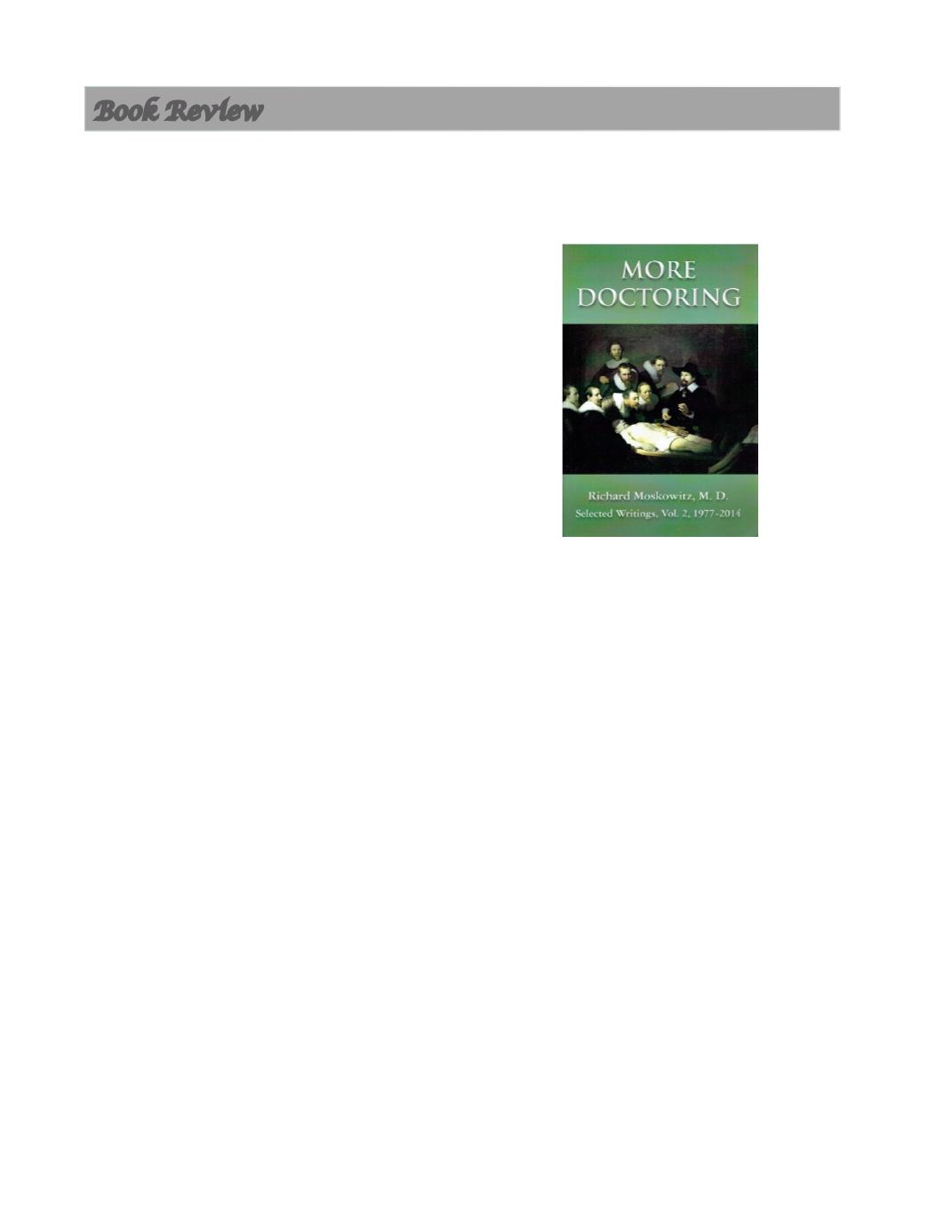
Volume 108 Number21
80 AJHM Summer 2015
By Richard Moskowitz, MD
Create Space Independent Publishing: N. Charleston, SC
Paperback. 381 pages. 2014
ISBN: 1502426684/ISBN13: 978150246680
$25 (US). Available on amazon.com or directly
from
More Doctoring: Selected Writings, Volume 2 (1977-2014)
Book Review
I
t is with a fair degree of humility that I embarked upon
writing this review given my long familiarity with the
quality of Dr. Moskowitz’s writings when I served as edi-
tor of the Journal. It was always a pleasure to receive his
submissions, given that I seldom had to change even one
word, and given the high quality of his prose.
More Doctoring
is a sequel to his earlier effort,
Plain
Doctoring
, and continues in that vein—a compilation of
his varied and prolific writing that space precluded him
from including in the first volume; many of these articles,
letters, and essays have been published elsewhere over the
years.
The book reflects both his clinical acumen and his philo-
sophical sophistication; further, his erudition and logical
reasoning capabilities shine in his reviews. The book brings
to bear the author’s sweeping grasp of many subjects and
disciplines—homeopathic politics, ethics, bioterrorism,
bird flu, homeopathic history, materia medica, clinical ho-
meopathy, case analysis, etc.—all written in an inimitable
style, elegantly phrased, logically considered, and deeply
enriched by personal memories and experience.
His writing possesses a unique blend of erudition and
humility that I find engaging. And it is readily apparent
that his professed shortcomings are modest—but part and
parcel of any busy homeopath’s practice, reflecting the
simple admission that nobody’s perfect. As one reads
through this volume, it becomes clear that Dr. Moskowitz’s
skill using homeopathic medicine is considerable.
The article “Two Childbirth Remedies,” which earlier
appeared in his fine book
Homeopathic Medicines for Preg-
nancy and Childbirth
(1992)
,
is excellent. His descriptions
of the two very important remedies
Caulophyllum
and
Cimicifuga
are vivid and memorable, and greatly enhanced
by his descriptions of their clinical application in his own
previous home birthing practice. After reading this article
and others in this volume, I was left with the impression
that Dr. Moskowitz should give serious consideration to
writing his own materia medica, based on his own clinical
experience.
His article “Vaccinations” (
Encyclopedia of Childbear-
ing: Critical Perspective
.1993) is a short piece that raises
concerns about vaccinations; these are issues Moskowitz
has addressed in more detail in previous papers published
in our own journal. His points are valid and worthy of seri-
ous consideration. Regretfully, this article lacks references
to bolster his assertions.
“Illness as Metaphor” is excellent and deserving of
wider lay readership. In it, Moskowitz gives ample case
examples illustrating the metaphorical applications of ho-
meopathic medicine. Certainly homeopathy (and perhaps
anthroposophical medicine) is the one of the medical fields
most conducive to the use of metaphor to effect cure.
The article “Drug Reactions and Biological Individuali-
ty” is another exceptional contribution, providing excellent
cases that ably illustrate the association of drug/substance
exposures, as well as miasms, with illness. The article fur-
ther illustrates many aspects of homeopathy convincingly;
e.g., remedy themes, efficacy over placebo, utility in sig-
nificant pathology. Any reader, lay person or homeopathic
professional can benefit from reading this article, and many
others in this book.
One tidbit of his professional history revealed in the
book, a description of his home visit to a patient that
resulted in an overnight vigil for a woman with severe
mastitis, evokes a rather romantic image of the old rural
homeopaths, traveling by horse and buggy to patients’
homes where they attended seriously ill patients, often all
night, and serves as a prime example of exceptional ‘plain
Reviewed by George Guess, MD, DHt


